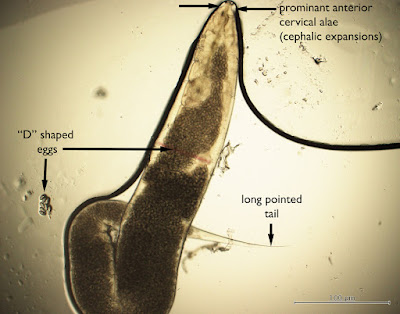Answer: Enterobius vermicularis (or E. gregorii); a.k.a. pinworm.
Several of you noted the classic features of the female pinworm shown in this case: the prominent anterior cervical alae, classic eggs (in and outside of the worm), and the slender "pin-like" tail that gives this worm its common name. Males also prominent cervical alae but lack the pointy tail; instead they have a blunt, often curved, posterior end with a single spicule.
As mentioned by Florida Fan, infected patients typically experience nocturnal anal pruritus, and the worm may be observed crawling on the surface of the stool. Ali Mokbel also noted that each work lays approximately 10,000 eggs each day. Importantly, these eggs are fully infectious within 4-6 hours of being laid, and this is one of the most important reasons why this worm is common in the United States and other resource-rich temperate climates. The eggs of most other intestinal nematodes require an incubation period in the soil before becoming infectious, and therefore infection can be prevented with proper sanitation measures, including waste treatment.
Thank you again to Dr. Kadkhoda for donating this classic case!
Sunday, November 26, 2017
Subscribe to:
Post Comments (Atom)




No comments:
Post a Comment